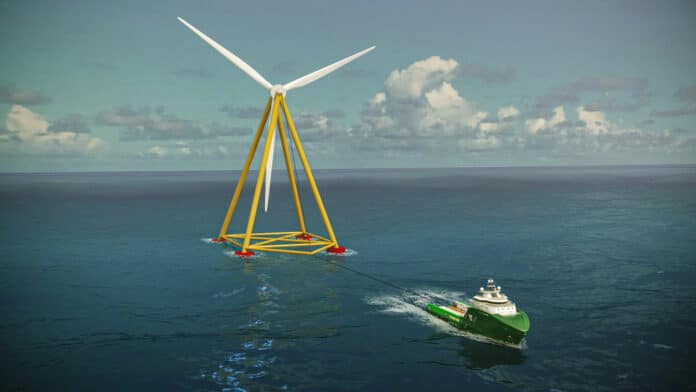Most of the world’s greatest wind power resources are located offshore; it faces many challenges, especially in deep waters where building typical fan-on-a-stick wind turbines with bases sunk deep into the sea floor is not feasible. Floating wind turbines are a potential solution, but they are currently much more costly and complex to build, deploy, and maintain than fixed-bottom offshore installations.
However, there are companies like Norway’s World Wide Wind and Boston startup T-Omega Wind that are working on innovative solutions to this problem. T-Omega Wind claims that its pyramid-based floating wind turbines are designed to minimize offshore wind costs. The company has already conducted wave tank testing and recently launched its first real-world prototype.
Its uniquely designed floating offshore wind turbine prototype was launched successfully off New Bedford, Massachusetts, earlier this week. The 1/16 scale demonstrator’s launch is a big step forward for T-Omega Wind and for the offshore wind industry.
T-Omega Wind’s demonstrator unit is designed to be significantly lighter, use fewer materials, and will not require specialized infrastructure for deployment and maintenance. The best part is that the shallow draft design enables the use of existing infrastructure and deployment in waters that are not viable for current solutions. This substantially reduces the cost compared to legacy technologies.

The prototype is 27 feet tall and will be placed in a cove for testing purposes. The T-Omega turbine has a distinctive pyramidal shape with four legs, which is different from the turbines that have been seen towering above Route 18 in New Bedford.
The turbine’s power generator – the nacelle – also differs from the typical design. Instead of sitting fixed and at the top of the turbine, the nacelle is disc-shaped and designed to move with the turbine. This allows it to adjust to the wind direction and speed more efficiently.
The company will monitor its performance and collect data for the next two to three months. This data will help them refine their design and optimize their technology for the full-scale version.
According to T-Omega, a full-size 10-megawatt turbine would place a 180-meter (590 feet) rotor, complete with variable pitch blades, on a 119-meter (390-foot)-high pyramid with 70-meter (230-ft) sides. The total system weight is estimated to be between 1,200 to 1,800 metric tons. It will provide annual electricity output of 44,000 MW-hours (at 50% capacity factor), which is enough to power more than 4,000 homes. Additionally, it will suppress 44,000 tons per year of carbon, equivalent to eliminating 9,000 internal combustion vehicles per year.
“Our team is thrilled to take this next step in launching our groundbreaking technology,” said T-Omega Wind CEO Brita Formato. “Floating offshore wind is a critical energy source for reaching multiple state and federal goals by 2030. The offshore wind industry is facing well-documented challenges.”
“T-Omega Wind’s radically redesigned floating offshore wind turbine will solve most of the challenges in an elegant and cost-effective manner. Our technology presents significant cost reductions in both production and installation/maintenance, entirely manufactured domestically. We are excited to showcase this technology to the world’s largest offshore wind developers, and we aim for full utility-scale deployments in the coming years.”
T-Omega Wind hopes to bring its commercial-scale product to the market by 2028 when the floating wind projects off the West Coast are slated to start. The “steel in the water” project in New Bedford is definitely a significant step towards achieving this goal. It’s amazing to see how renewable energy technology is advancing, and T-Omega Wind’s efforts will contribute to a more sustainable future.
